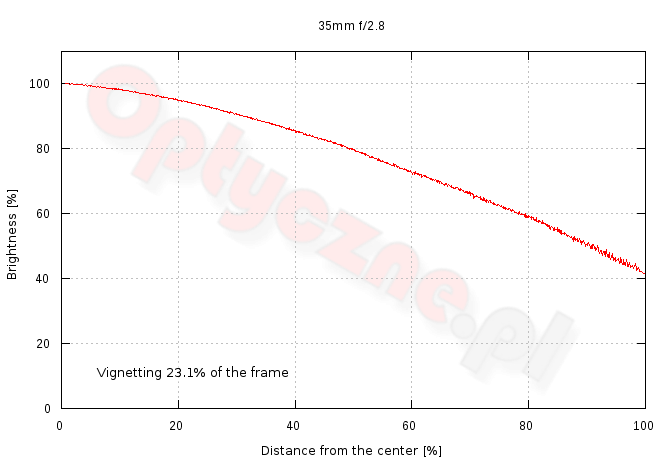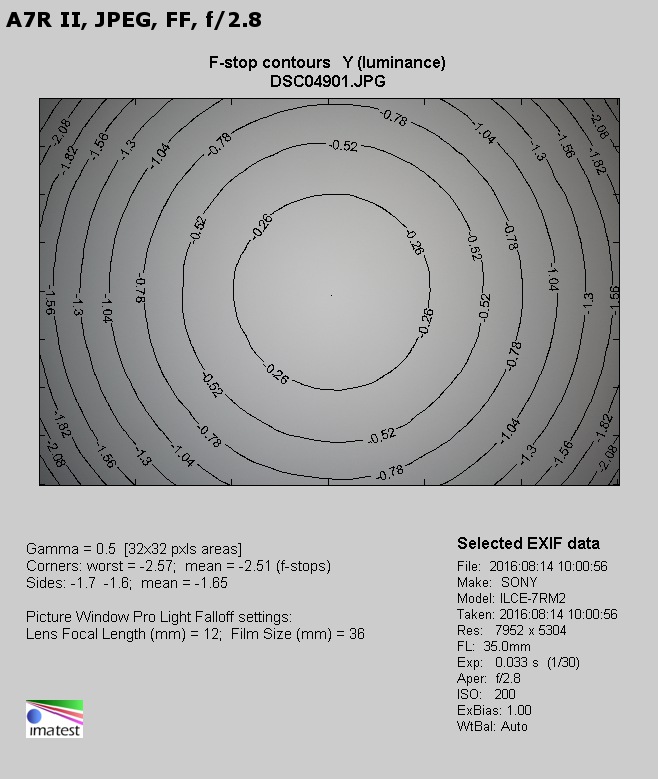Sony Carl Zeiss Sonnar T* FE 35 mm f/2.8 ZA
8. Vignetting
| A7R II, APS-C, f/2.8 | A7R II, APS-C, f/4.0 |

|

|
| A7R II, APS-C, f/5.6 | A7R II, APS-C, f/8.0 |

|

|
At the maximum relative aperture even the smaller sensor won’t protect you from the vignetting as its level reaches 31% (−1.07 EV). Still by f/4.0 it decreases to a moderate value of 20% (−0.66 EV). You can eliminate those problems only by f/5.6 and f/8.0, where we got respectively 13% (−0.39 EV) and 12% (−0.37 EV).
Please Support UsIf you enjoy our reviews and articles, and you want us to continue our work please, support our website by donating through PayPal. The funds are going to be used for paying our editorial team, renting servers, and equipping our testing studio; only that way we will be able to continue providing you interesting content for free. |
- - - - - - - - - - - - - - - - - - - - - - - - - - - - - - - - - - - - - - - - - - - - - - - -
Small physical dimensions of the lens itself and its elements along with the appearance of defocused light circles we presented in the previous chapter made us rather apprehensive when it comes to the full frame results. Let’s glance at the thumbnails first.
| A7R II, FF, f/2.8 | A7R II, FF, f/4.0 |

|

|
| A7R II, FF, f/5.6 | A7R II, FF, f/8.0 |

|

|
Not only the vignetting level is huge, it also reacts weakly to stopping down. At the maximum relative aperture the brightness loss in the frame corners reaches a very high level of 58% (−2.51 EV). On stopping down the aperture to f/4.0 you make it decrease to a still distinct level of 51% (−2.03 EV). Even by f/5.6 the vignetting remains conspicuous, amounting to 46% (−1.77 EV); after that the situation hardly improves. By f/8.0 that aberration reaches 40% (−1.50 EV), and by f/11 it is 35% (−1.25 EV). Even by f/16 and f/22 the vignetting remains noticeable as it amounts to, respectively, 30% (−1.02 EV) and 26% (−0.88 EV).
Below we present the averaged out values of brightness loss in concentric circles as you move away from the frame centre. The percentage numbers in every picture state the size of the real surface area limited from above and from the right with a value of 100% and from below by the presented curve. That’s how you know how much light overall is lost due to the vignetting. Still you shouldn’t mix up those percentage values with the ones, given at the beginning of the chapter because they are not directly connected with each other.

 |






